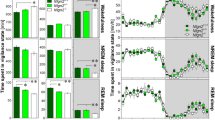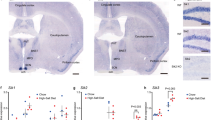Abstract
Infectious challenge can trigger alterations in sleep–wake behavior. Accumulating evidence has shown that the serine/threonine kinases Akt1 and Akt2 are important targets in both physiological and infectious signaling processes. However, the involvement of Akt1 and Akt2 in sleep–wake activity under basal conditions and in response to inflammatory stimulation has not been established. In the present study, we assessed the precise role of Akt1 and Akt2 in sleep–wake behavior using electroencephalography (EEG)/electromyography (EMG) data from Akt1- and Akt2-deficient mice and wild-type (WT) mice. The results showed that both Akt1 and Akt2 deficiency affect sleep–wake activity, as indicated by reduced nonrapid eye movement (NREM) sleep and increased wakefulness in mutant mice compared to WT mice. Sleep amount and intensity (delta, theta and alpha activity) at night were also drastically attenuated in Akt1- and Akt2-deficient mice. Moreover, since Akt1 and Akt2 are involved in immune responses, we assessed their roles in the sleep response to the inflammatory stimulus lipopolysaccharide (LPS) throughout the following 24 h. We observed that the decrease in wakefulness and increase in NREM sleep induced by LPS were restored in Akt1 knockout mice but not in Akt2 knockout mice. Correspondingly, the decrease in the number of positive orexin-A neurons induced by LPS was abrogated in Akt1 knockout mice but not in Akt2 knockout mice. Our results revealed that both Akt1 and Akt2 deficiency affect the sleep response under basal conditions, but only Akt1 deficiency protects against the aberrant changes in sleep behavior induced by peripheral immune challenge.






Similar content being viewed by others
References
Chase MH. Motor control during sleep and wakefulness: clarifying controversies and resolving paradoxes. Sleep Med Rev. 2013;17:299–312.
Besedovsky L, Lange T, Haack M. The sleep-immune crosstalk in health and disease. Physiol Rev. 2019;99:1325–80.
Dupont D, Lin J-S, Peyron F, Akaoka H, Wallon M. Chronic Toxoplasma gondii infection and sleep-wake alterations in mice. CNS Neurosci Ther. 2021;27:895–907.
Ragnoli B, Pochetti P, Pignatti P, Barbieri M, Mondini L, Ruggero L, et al. Sleep deprivation, immune suppression and SARS-CoV-2 infection. Int J Environ Res Public Health. 2022; 19.
Guerau-de-Arellano M, Piedra-Quintero ZL, Tsichlis PN. Akt isoforms in the immune system. Front Immunol. 2022;13: 990874.
Liu H, Stepicheva NA, Ghosh S, Shang P, Chowdhury O, Daley RA, et al. Reducing Akt2 in retinal pigment epithelial cells causes a compensatory increase in Akt1 and attenuates diabetic retinopathy. Nat Commun. 2022;13:6045.
Di Lorenzo A, Fernandez-Hernando C, Cirino G, Sessa WC. Akt1 is critical for acute inflammation and histamine-mediated vascular leakage. Proc Natl Acad Sci USA. 2009;106:14552–7.
Babaev VR, Hebron KE, Wiese CB, Toth CL, Ding L, Zhang Y, et al. Macrophage deficiency of Akt2 reduces atherosclerosis in Ldlr null mice. J Lipid Res. 2014;55:2296–308.
Nie Y, Sun L, Wu Y, Yang Y, Wang J, He H, et al. AKT2 regulates pulmonary inflammation and fibrosis via modulating macrophage activation. J Immunol. 2017;198:4470–80.
Nie Y, Wang Z, Chai G, Xiong Y, Li B, Zhang H, et al. Dehydrocostus Lactone Suppresses LPS-induced Acute Lung Injury and Macrophage Activation through NF-κB Signaling Pathway Mediated by p38 MAPK and Akt. Molecules. 2019; 24.
Dummler B, Tschopp O, Hynx D, Yang ZZ, Dirnhofer S, Hemmings BA. Life with a single isoform of Akt: mice lacking Akt2 and Akt3 are viable but display impaired glucose homeostasis and growth deficiencies. Mol Cell Biol. 2006;26:8042–51.
Palumbo S, Paterson C, Yang F, Hood VL, Law AJ. PKBbeta/AKT2 deficiency impacts brain mTOR signaling, prefrontal cortical physiology, hippocampal plasticity and select murine behaviors. Mol Psychiatry. 2021;26:411–28.
Chang CY, Chen YW, Wang TW, Lai WS. Akting up in the GABA hypothesis of schizophrenia: Akt1 deficiency modulates GABAergic functions and hippocampus-dependent functions. Sci Rep. 2016;6:33095.
Islam MT, Rumpf F, Tsuno Y, Kodani S, Sakurai T, Matsui A, et al. Vasopressin neurons in the paraventricular hypothalamus promote wakefulness via lateral hypothalamic orexin neurons. Curr Biol. 2022.
Li S-B, Damonte VM, Chen C, Wang GX, Kebschull JM, Yamaguchi H, et al. Hyperexcitable arousal circuits drive sleep instability during aging. Science. 2022;375: eabh3021.
Adamantidis AR, Zhang F, Aravanis AM, Deisseroth K, de Lecea L. Neural substrates of awakening probed with optogenetic control of hypocretin neurons. Nature. 2007;450:420–4.
Gaykema RP, Goehler LE. Lipopolysaccharide challenge-induced suppression of Fos in hypothalamic orexin neurons: their potential role in sickness behavior. Brain Behav Immun. 2009;23:926–30.
Tanaka S, Toyoda H, Honda Y, Seki Y, Sakurai T, Honda K, et al. Hypocretin/orexin prevents recovery from sickness. Biomedical reports. 2015;3:648–50.
Zhao P, Shao YF, Zhang M, Fan K, Kong XP, Wang R, et al. Neuropeptide S promotes wakefulness through activation of the posterior hypothalamic histaminergic and orexinergic neurons. Neuroscience. 2012;207:218–26.
Maloney KJ, Cape EG, Gotman J, Jones BE. High-frequency gamma electroencephalogram activity in association with sleep-wake states and spontaneous behaviors in the rat. Neuroscience. 1997;76:541–55.
Alexaki VI, Fodelianaki G, Neuwirth A, Mund C, Kourgiantaki A, Ieronimaki E, et al. DHEA inhibits acute microglia-mediated inflammation through activation of the TrkA-Akt1/2-CREB-Jmjd3 pathway. Mol Psychiatry. 2018;23:1410–20.
Appelbaum L, Wang G, Yokogawa T, Skariah GM, Smith SJ, Mourrain P, et al. Circadian and homeostatic regulation of structural synaptic plasticity in hypocretin neurons. Neuron. 2010;68:87–98.
De Luca R, Nardone S, Grace KP, Venner A, Cristofolini M, Bandaru SS, et al. Orexin neurons inhibit sleep to promote arousal. Nat Commun. 2022;13:4163.
Nixon JP, Mavanji V, Butterick TA, Billington CJ, Kotz CM, Teske JA. Sleep disorders, obesity, and aging: the role of orexin. Ageing Res Rev. 2015;20:63–73.
Szentirmai E, Massie AR, Kapas L. Lipoteichoic acid, a cell wall component of Gram-positive bacteria, induces sleep and fever and suppresses feeding. Brain Behav Immun. 2021;92:184–92.
Szentirmai É, Krueger JM. Sickness behaviour after lipopolysaccharide treatment in ghrelin deficient mice. Brain Behav Immun. 2014;36:200–6.
Zhang B-J, Shao S-R, Aritake K, Takeuchi A, Urade Y, Huang Z-L, et al. Interleukin-1β induces sleep independent of prostaglandin D in rats and mice. Neuroscience. 2017;340:258–67.
Hogan D, Morrow JD, Smith EM, Opp MR. Interleukin-6 alters sleep of rats. J Neuroimmunol. 2003;137:59–66.
Beard RS, Hoettels BA, Meegan JE, Wertz TS, Cha BJ, Yang X, et al. AKT2 maintains brain endothelial claudin-5 expression and selective activation of IR/AKT2/FOXO1-signaling reverses barrier dysfunction. J Cereb Blood Flow Metab. 2020;40:374–91.
Igarashi S, Nozu T, Ishioh M, Kumei S, Saito T, Toki Y, et al. Centrally administered orexin prevents lipopolysaccharide and colchicine induced lethality via the vagal cholinergic pathway in a sepsis model in rats. Biochem Pharmacol. 2020;182: 114262.
Arranz A, Doxaki C, Vergadi E, Martinez de la Torre Y, Vaporidi K, Lagoudaki ED, et al. Akt1 and Akt2 protein kinases differentially contribute to macrophage polarization. Proc Natl Acad Sci USA. 2012;109:9517–22.
Acknowledgements
This study was supported by Wuxi Municipal Bureau on Science and Technology (Y20222012).
Funding
This study was supported by Wuxi Municipal Bureau on Science and Technology (Y20222012).
Author information
Authors and Affiliations
Contributions
Peng Zhao designed the experiments; Meng Cui, Pengfei Meng, Qingyuan Feng, and Guangming Liu performed the experiments and analyzed the data; Meng Cui prepared the manuscript.
Corresponding author
Ethics declarations
Conflict of interest
All authors declare that they have no conflict of interest.
Ethical committee permission
Experimental protocols were approved by the Animal Ethics Committee of Jiangnan University (JN. No20190415c0420228[83]).
Animals
Male C57BL/6 mice were obtained from Shanghai SLAC Laboratory Animal Co., Ltd. Shanghai Jiaotong University graciously donated Akt1 knockout mice and Akt2 knockout mice.
Additional information
Publisher's Note
Springer Nature remains neutral with regard to jurisdictional claims in published maps and institutional affiliations.
Supplementary Information
Below is the link to the electronic supplementary material.
Rights and permissions
Springer Nature or its licensor (e.g. a society or other partner) holds exclusive rights to this article under a publishing agreement with the author(s) or other rightsholder(s); author self-archiving of the accepted manuscript version of this article is solely governed by the terms of such publishing agreement and applicable law.
About this article
Cite this article
Cui, M., Meng, P., Wang, S. et al. Differential effects of AKT1 and AKT2 on sleep–wake activity under basal conditions and in response to LPS challenge in mice. Sleep Biol. Rhythms (2024). https://doi.org/10.1007/s41105-024-00519-y
Received:
Accepted:
Published:
DOI: https://doi.org/10.1007/s41105-024-00519-y




